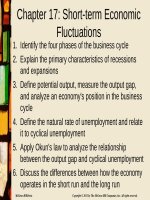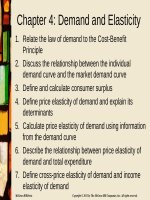Lecture Principles of economics (Asia Global Edition) - Chapter 3
Bạn đang xem bản rút gọn của tài liệu. Xem và tải ngay bản đầy đủ của tài liệu tại đây (667.56 KB, 44 trang )
Supply and Demand
Chapter 3
McGrawHill/Irwin
Copyright © 2015 by McGrawHill Education (Asia). All rights reserved. 31
Learning Objectives
1.
2.
3.
4.
Describe how the demand and supply curves
summarize the behavior of buyers and sellers in
the marketplace.
Discuss how the supply and demand curves
interact to determine equilibrium price and
quantity.
Illustrate how shifts in supply and demand
curves cause prices and quantities to change
Explain and apply the Efficiency Principle and
the Equilibrium Principle (also called “The NoCash-on-the-Table Principle).
32
What, How, and For Whom?
•
Every society answers three basic questions
WHAT
§
§
HOW
§
§
FOR
WHOM
§
Which goods will be produced?
How much of each?
Which technology?
Which resources are used?
How are outputs distributed?
§
§
Need?
Income?
33
Central Planning versus the
Market
Central Planning
Decisions by
individuals or small
groups
•
Agrarian societies
•
Government programs
Sets prices and goals for the
group
•
Individual influence is
limited
•
Resources and goods are
allocated accordingly
Interaction of supply and
demand answer the three
basic questions
•
•
–
The Market
Buyers and sellers
signal wants and costs
–
Mixed economies use both the market and central planning
34
Buyers and Sellers in the
Market
•
•
The market for any good consists of all the
buyers and sellers of the good
Buyers and sellers have different motivations
–
–
•
Buyers want to benefit from the good
Sellers want to make a profit
Market price balances two forces
–
–
Value buyers derive from the good
Cost to produce one more unit of the good
35
Demand
•
•
A demand curve
illustrates the quantity
buyers would purchase
at each possible price
Demand curves have a
negative slope
•
•
Consumers buy less at
higher prices
Consumers buy more at
lower prices
Demand for Donuts
P
$4
$2
D
8
16
Q
(000s of pieces/day)
36
Demand Slopes Downward
•
Buyers value goods differently
–
•
The buyer’s reservation price is the highest price
an individual is willing to pay for a good
Demand reflects the entire market, not one
consumer
–
–
Lower prices bring more buyers into the market
Lower prices cause existing buyers to buy more
37
Income and Substitution Effects
•
•
Buyers buy more at lower prices and buy less at
higher prices
What happens when price goes up?
–
–
The substitution effect: Buyers switch to
substitutes when price goes up
The income effect: Buyers' overall purchasing
power goes down
38
Interpreting the Demand Curve
Horizontal
interpretation of
demand:
•
Demand for Donuts
P
•
$4
•
$2
D
8
16
Q
Given price, how much
will buyers buy?
At a price of $4, the
quantity demanded is
8,000 slices/day.
(000s of pieces/day)
39
Interpreting the Demand Curve
–
Demand for Donuts
P
$4
$2
D
8
16
(000s of pieces/day)
Q
Vertical interpretation of
demand:
•
Given the quantity to
be sold, what price is
the marginal consumer
willing to pay?
•
If 8,000 slices are sold
the marginal consumer
is willing to pay $4 per
slice.
310
The Supply Curve
•
•
•
•
The supply curve illustrates the quantity of a
good that sellers are willing to offer at each price
– If the price is less than opportunity cost, offer
more
Opportunity cost differs among sellers due to
– Technology ■ Different costs such as rent
– Skills
■ Expectations
The Low-Hanging Fruit Principle explains the
upward sloping supply curve
The seller’s reservation price is the lowest price
the seller would be willing to sell for
– Equal to marginal cost
311
Interpreting the Supply Curve
Supply of Donuts
Horizontal
interpretation of
supply:
•
P
S
$4
•
$2
•
8
16
Q
Given price, how much
will suppliers offer?
At a price of $2,
suppliers are willing to
sell 8,000 pieces/day.
(000s of pieces/day)
312
Interpreting the Supply Curve
–
Supply of Donuts
P
S
$4
$2
8
16
(000s of pieces/day)
Q
Vertical interpretation of
supply:
•
Given the quantity to
be sold, what is the
opportunity cost of the
marginal seller?
•
If 8,000 pieces are
sold, the marginal cost
of producing the
8,000th piece is $2.
313
Market Equilibrium
•
•
•
•
A system is in equilibrium when there is no
tendency for it to change
The equilibrium price is the price at which the
supply and demand curves intersect
The equilibrium quantity is the quantity at
which the supply and demand curves intersect
The market equilibrium occurs when all buyers
and sellers are satisfied with their respective
quantities at the market price
–
At the equilibrium price, quantity supplied equals
quantity demanded
314
Market Equilibrium
Quantity supplied
equals quantity
demanded AND
Price is on supply
and demand curves
No tendency to
change P or Q
•
•
•
•
•
Buyers are on their
demand curve
Sellers are on their
supply curve
Market for Donuts
P
S
$3
D
12
Q
(000s of pieces/day)
315
Excess Supply and Excess
Demand
Excess Supply
–
Excess Demand
At $4, 16,000 pieces supplied
and 8,000 slices demanded
–
At $2, 8,000 pieces supplied
16,000 slices demanded
Market for Donuts
P
Market for Donuts
P
Surplus
S
S
$4
Shortage
$2
D
8
16
(000s of pieces/day)
D
Q
8
16
Q
(000s of pieces/day)
316
Incentive Principle: Excess
Supply at $4
–
–
–
Each supplier has an
incentive to decrease the
price in order to sell more
Lower prices decrease the
surplus
As price decreases:
•
the quantity offered for sale
decreases along the supply
curve
•
the quantity demanded
increases along the
demand curve
Market for Donuts
P
S
$4
$3.50
$3
Equilibrium
D
8 12 16
Q
(000s of pieces/day)
317
Incentive Principle: Excess
Demand at $2
–
Market for Donuts
P
–
S
–
$3
$2.50
$2
Equilibrium
D
8 12 16
(000s of pieces/day)
Q
Each supplier has an
incentive to increase the
price in order to sell more
Higher prices decrease the
shortage
As price increases
•
the quantity offered for
sale increases along the
supply curve
•
As price increases, the
quantity demanded
decreases along the
demand curve.
318
Rent Controls Are Price Ceilings
–
–
–
A price ceiling is a
maximum allowable price,
set by law
Rent controls set a maximum
price that can be charged for
a given apartment
If the controlled price is
below equilibrium, then:
•
Quantity demanded
increases
•
Quantity supplied
decreases
•
A shortage results
Market for New York City Apartments
P
S
$1,600
$800
D
1
2
3
Q
(millions of apartments/day)
319
Movement along the Demand
Curve
•
•
•
When price goes up,
quantity demanded
goes down
When price goes
down, buyers move to
a new, higher quantity
demanded
A change in quantity
demanded results
from a change in the
price of a good.
Demand for Canned Tuna
P
$2
$1
D
8 10
Q
(000s of cans/day)
320
Shift in Demand
If buyers are willing to
buy more at each price,
then demand has
increased
•
•
•
•
Move the entire demand
curve to the right
Change in demand
If buyers are willing to
buy less at each price,
then demand has
decreased
Demand for Canned Tuna
P
$2
D
8
10
D'
Q
(000s of cans/day)
321
Movement Along the Supply
Curve
•
•
•
When price goes up,
quantity supplied
goes up
When price goes up,
sellers move to a
new, higher quantity
supplied
A change in quantity
supplied results from
a change in the price
of a good.
Supply of Donuts
P
S
$4
$2
8
16
Q
(000s of pieces/day)
322
Shift in Supply
Supply increases when
sellers are willing to offer
more for sale at each
possible price
•
•
Moves the entire supply
curve to the right
Supply of
P Donuts
$
2
Supply decreases when
sellers are willing to offer
less for sale at each
possible price
•
•
Moves the entire supply
curve to the left
Supply of Tuna
S
P
S*
S
S'
$
2
8
9
(000s of
pieces/day)
Q
8
9
Q
(000s of cans/day)
323
Tennis Market
–
If rent for tennis court decreases, demand for tennis
balls increases
•
P
Tennis courts and tennis balls are complements
Tennis Court Rentals
P
Tennis Ball Sales
S
$10
$1.40
$1.00
$7
D'
D
D
4
11
(00s rentals/day)
Q
40
58
Q
(millions of balls/day)
324
Causes of Shifts in Demand
•
Price of complementary goods
–
•
Price of substitute goods
–
•
•
•
Internet and overnight delivery are substitutes
Income: normal or inferior goods?
Preferences
–
•
Tennis courts and tennis balls
Dinosaur toys after Jurassic Park movie
Number of buyers in the market
Expectations about the future
Price changes never cause a shift in demand
325









